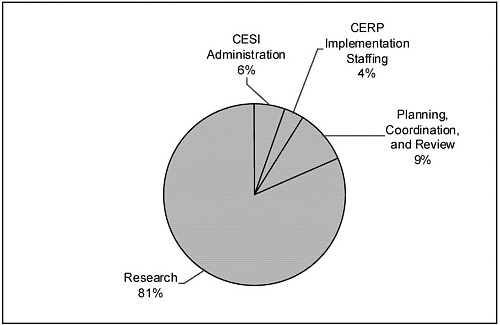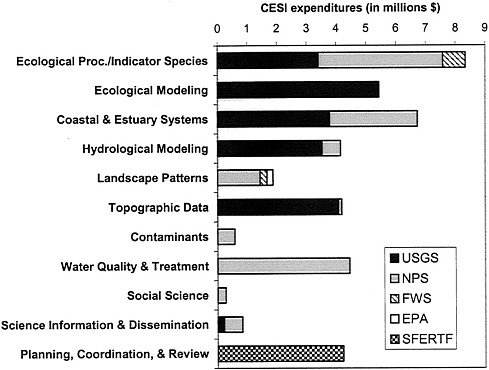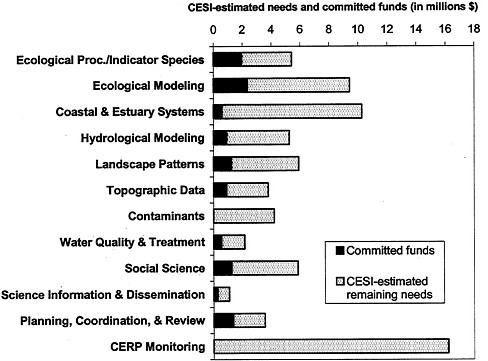4
Financial Resources
An assessment of opportunities for strengthening the Critical Ecosystem Studies Initiative (CESI) requires an understanding of the financial support for the initiative. The programs defined in Chapter 2 for the accomplishment of science in the service of restoration in South Florida and the program management improvements proposed in Chapter 3 require financial resources. This chapter provides a brief overview of the financial resources of the CESI program by describing the congressionally appropriated funds over the life of the program, the distribution of those funds by project activity, and other sources of funding for science research affecting the greater Everglades ecosystem and the restoration effort. The chapter also provides an evaluation of the current financial resources for the CESI program.
CESI FINANCIAL RESOURCES
In January 1996, Secretary of the Interior Bruce Babbitt published A Comprehensive Plan for the Restoration of the Everglades (DOI, 1996). The plan proposed that a total of $100–$ 150 million per year in additional funding be provided to the Department of the Interior (DOI) for FY 1997–2002 to accelerate restoration progress within three areas:
-
land acquisition ($40–$60 million per year)
-
infrastructure projects ($40–$60 million per year)
-
modeling and scientific research ($20–$30 million per year)
With DOI support for the proposed plan, the CESI program was initiated in FY 1997. Although the initial research costs were assessed at $20 million per year or more to address the science and information gaps, DOI requested $12.8 million for the first year. Congress initially appropriated $7.2 million for the CESI program, with $12 million appropriated in FY 1998. Although CESI managers had requested large sums for research, they were not prepared to actually manage
these amounts, and therefore they were slow in dispersing the research funds. Additionally, because of disruptions in the congressional budget process (including governmental “shutdowns”), funds became available very late in 1997. These two forces resulted in relatively slow allocation of initial CESI funds to researchers, even though construction activity was moving forward and needed information from research projects.
The history of congressionally appropriated funds for the CESI program shows that there has been a decline of funding over recent years (Table 4–1). After the first year, the program reached its peak funding level of $12 million for FY 1998 and 1999, followed by large reductions in funding in FY 2000 and again in FY 2002, leading to the present level of funding of $4 million per year. These reductions in funding came at a time when the demand for scientific results to provide guidance for planning and construction in the restoration efforts was increasing.
The reductions in funding for the CESI program shown in Table 4–1 resulted from declining budgetary requests to Congress. The CESI funding requests were decreased for four reasons (DOI, 2002). First, the CESI program had been slow in spending its initial infusions of funding. The reasons outlined above were not obvious to the Office of Management and Budget (OMB) or DOI budget managers, and they were concerned that the CESI program simply could not manage a larger flow of funding. Second, there were serious concerns about the strategy and effectiveness of the CESI program. OMB managers wanted to see clearly defined linkages between money spent and useful, measurable scientific out-comes—an exercise that is always difficult for science. Many ecological research projects require years of data collection, and the restoration benefits derived from this critical information were likely to be at least a decade away. Third, funding tradeoffs occurred within DOI to provide additional funds for activities related to the Comprehensive Everglades Restoration Plan (CERP), including land acquisition and staffing needs, by subtracting funds from the CESI program. Land acquisition was an attractive magnet for funding, because it involved matching funds from the state of Florida. Finally, DOI continually balances competing requests for other projects completely outside the issue of Everglades restoration with requests for CESI funds. Political and economic pressures provide potent forces that enter this process at all levels. By considering these four issues in future budget requests, CESI managers may be able to compete more effectively for research funding within DOI.
All of the funding associated with the CESI program does not go for direct support of scientific research (Figure 4–1). As with most research, a portion is relegated to administration of research personnel and resources. For the CESI program, this portion is relatively low—only 6 percent of total costs for 1997– 2002. These funds are used to support the position of the CESI coordinator and to fund CESI administrative expenses. Additional nonresearch expenditures include $1.7 million in CESI funds that were reprogrammed in FY 2001 to address CERP-related needs within DOI. These reprogrammed CESI funds were
TABLE 4–1 Original Congressionally Appropriated Funding for the CESI Program, Fiscal Years 1997–2002
|
Fiscal Year |
Total CESI Funding |
Appropriations for Planning, Coordination, and Reviewa |
Fraction of CESI Funds for Planning, Coord., and Review (%) |
|
1997 |
$7,200,000 |
$47,500 |
0.7 |
|
1998 |
12,000,000 |
1,140,000 |
9.5 |
|
1999 |
12,000,000 |
570,000 |
4.8 |
|
2000 |
7,908,000 |
603,250 |
7.6 |
|
2001b |
7,908,000 |
982,110 |
12.4 |
|
2002 |
4,000,000 |
531,050 |
13.3 |
|
2003 request |
4,000,000 |
Not available |
Not available |
combined with new CERP-designated funding1 to meet critical DOI staffing needs for inform restoration planning, adequate numbers of staff were needed to communicate the available research findings to the restoration planning teams, and CESI funding was reallocated to address this need.
aAppropriations for planning, coordination, and review do not include allocations to support tribal water quality studies or CESI administrative costs.
bFY 2001 appropriation was later reduced to $6,191,000 due to budget reprogramming for CERP.
SOURCE: SFERTF (2002); William Perry, NPS, written communication(2002).
CESI funding was also used to support restoration planning, coordination, and review activities. During 1997–2002, these planning funds have averaged 9 percent of the CESI program's total expenditures (Figure 4–1), although their percentage of the yearly budget has generally increased as the CESI budget has declined (Table 4–1). The South Florida Ecosystem Restoration Task Force, rather than the National Park Service, managed the funds used for restoration planning, and these funds were allocated on a noncompetitive basis. Total nonresearch expenses for the CESI program, including administration, CERP implementation, and planning, coordination, and review costs, average 19 percent of the CESI budget over FY 1997–2002. More than $3 million in CESI funds were also provided to fund water-quality research and monitoring by the Seminole and Miccosukee tribes. Although these funds were distributed through noncompetitive allocations as a part of DOI's trust responsibility to Native American tribes, the funds were used for data collection and scientific research and were classified as research in this analysis.
|
1 |
CERP-designated funding for the National Park Service amounted to $2.5 million in FY 2001 (including the $1.7 million reappropriated from CESI) and $5.5 million in FY 2002 and in FY 2003 (requested). The Fish and Wildlife Service also received CERP-designated allocations of $651,000 in FY 2001 and $3.35 million in FY 2002 and in FY 2003 (requested) (SFERTF, 2002). |

FIGURE 4–1 End uses of CESI funding, averaged over the period 1997–2002.
SOURCE: William Perry, NPS, written communication, 2002.
Four sponsoring agencies received CESI funding for scientific research during FY 1997–2002: the U.S. Geological Survey (USGS), the National Park Service (NPS), the Fish and Wildlife Service (FWS), and the U.S. Environmental Protection Agency (EPA) (Figure 4–2a). These sponsoring agencies completed a portion of the work themselves, while also contracting with universities, other federal, state, and local government agencies, consulting firms, and nonprofit organizations to conduct the studies needed (Figure 4–2b). The USGS and NPS together received nearly all of the CESI funding (96 percent) as sponsoring agencies, while the USGS and universities received the largest portions of the funding to conduct the research. The USGS has both sponsored the largest portion of CESI funded research and conducted the greatest fraction of the research.
The CESI program's expenditures by program category highlight its strongest and weakest areas of research contributions (Figure 4–3). Specifically, the program categories of Ecological Processes/Indicator Species and Coastal and Estuary Systems have received the highest allocations of funding to date, followed by Ecological Modeling. Research programs that have received the fewest allocations include Science Information and Dissemination, Contaminants, and Social Science. Examples of CESI research contributions from these various program categories and an assessment of remaining research needs are described in Chapter 2, while individual project's and their costs are detailed in Appendix A. More than one sponsoring agency usually engages in any given research category. The USGS has received the majority of the funds to support Ecological Modeling, Hydrological Modeling, and Topographic Data, but it is also a primary agency in the Coastal and Estuary Systems and Ecological Processes/Indicator Species program categories along with the NPS (Figure 4–3). The FWS and the NPS have sponsored research on population success and long-term monitoring of

FIGURE 4–3 CESI expenditures subdivided by sponsoring agency. CESI program area funds obligated as of March 2002. Funding within each category has been subdivided by sponsoring agency. The Water Quality and Treatment and Water Quality on Tribal Lands program categories have been combined under Water Quality and Treatment. The projects under Planning, Coordination, and Review are nonresearch costs and represent the appropriated amounts. SOURCE: William Perry, NPS, written communication, 2002.
ecosystem species, reflected under the Ecological Processes/Indicator Species and Landscape Patterns program categories. The NPS has also sponsored all of the research in the Contaminants, Water Quality and Treatment, and Social Science program categories.
The CESI program is not the only source of funding for South Florida ecosystem science. Within DOI, “place-based” research in the South Florida region by the USGS (http://sofia.usgs.gov/) has a distinct focus on the greater Everglades ecosystem, and much of what is learned from the effort is applicable to restoration. During the past three years, funding for the USGS South Florida place-based research has grown from $6.5 million to about $8 million per year while annual funding for the CESI program has declined from $12 million to $4 million. The USGS funding increase cannot be viewed as a replacement for the CESI budgetary decline, however, because the USGS place-based research topics were selected independently from the overall CESI strategic funding plan. An evaluation of USGS South Florida place-based research investments and their support for the restoration science needs was not feasible within the scope of this review.
Additional investment in Everglades-related research includes funds for ecosystem research provided by the National Science Foundation (NSF). The NSF
supports individual investigators in basic science projects related to the greater Everglades ecosystem, as well as long-term investigations by a large group of researchers associated with the Florida Coastal Everglades Long Term Ecological Research (FCE-LTER) project (http://fcelter.fiu.edu/). The LTER work is ecosystem-oriented and is driven by basic questions about the biology of the system. Some of the outcome of this work is useful for restoration planning, although LTER's emphasis is on basic science. The South Florida Water Management District (SFWMD), U.S. Army Corps of Engineers (the Corps), National Oceanic and Atmospheric Administration (NOAA), Environmental Protection Agency, and Florida Marine Research Institute also contribute valuable scientific research related to the restoration effort. According to the 2001 Cross Cut Budget, sizable financial allocations have been made for these agencies ' restoration-related research and monitoring programs. The largest investments have come from NOAA and the SFWMD. In FY 2001, the NOAA budget for scientific research on the marine environment exceeded $5 million, and the SFWMD allocated more than $40 million for both research and monitoring efforts (SFERTF, 2002).
EVALUATION OF CESI FINANCIAL RESOURCES
In general, it appears that the early science funds for the CESI program were sufficient to initiate the needed research, but the smaller budgets of recent years have been inadequate to support full development of the science to support fast-moving restoration planning. Additionally, insufficient staff resources exist to provide the necessary synthesis, dissemination, and integration of existing CESI data. In the coming years, monitoring and environmental assessments, and the research associated with designing and interpreting the results of these activities, will place an extra burden on the CESI budget. Original estimates of the requirements for science (DOI, 1996) were far larger than the amount of support that has been provided, and as a result many of the identified science gaps remain unaddressed (see Chapter 2). CESI managers have identified additional research and monitoring objectives to address some of these gaps for FY 2002–2006 (Figure 4–4, examples in Appendix C). Although discussions are needed with experts from the scientific and restoration community to review these objectives, existing funding levels will meet less than a third of the CESI program's anticipated needs. Meanwhile, these identified science needs merely represent a snapshot in time, and funding must also be available to address the most critical new restoration-related science questions as they arise. The CESI program should identify priority research topics in under-funded areas and formulate effective research programs based on rigorous peer-review procedures. CESI managers should then develop budget estimates and seek additional funding to support these programs. Recommended CESI management and program improvements for synthesis, peer review, and dissemination will also place new demands on current funds (see Chapters 3 and 5).

FIGURE 4–4 CESI-estimated funding needs by program category over the period FY 2002—FY 2006 and currently committed CESI funds. Note that currently committed funds include CESI budget carryovers from previous years, since committed funds exceed current budget of $4 million for FY 2002. Water-quality technology remaining needs may be an underestimate because of some missing data within this category. Also, interagency program support was not included in this analysis. SOURCE: William Perry, NPS, written communication, 2002.
Early scientific research can reduce uncertainly in restoration planning and, therefore, represents an investment toward the likelihood of achieving the restoration goals. Inadequate science support now may result in exponentially increased costs later if failed restoration projects must be redesigned based on unforeseen consequences. Scientific research and environmental assessments will also provide a critical foundation for DOI's future consultation, concurrence, and reporting responsibilities for CERP (USAGE, 2002b). The CESI program has provided an agile, multi-agency approach to address many of the restoration 's science information gaps, providing a rich database, enhanced understanding of South Florida's ecosystem dynamics, and improved modeling tools for restoration planning and decision making. Congress should increase CESI research funding to meet DOI's current restoration science needs, contingent upon making the recommended management changes outlined as first-priority improvements in Chapter 3. These changes include (1) adhering to and substantially improving the standards for proposal dissemination and review and (2) broadening the involvement of expert advisors in the priority-setting and proposal-review processes. These management changes can be made both quickly and inexpensively and will substantially strengthen the program, ensuring that new research funds are directed efficiently to appropriate science priorities and with an adequate
peer-review structure in place. Other recommended management and programmatic changes outlined in this report (e.g., enhanced dissemination, strengthened synthesis, improved funding accountability, and development of an independent fast-track peer-review process; see Chapters 2, 3, and 5) are no less critical but may require additional time or resources to implement. The restoration science needs are simply too important and too urgently needed to delay the contributions from additional research funding. Nevertheless, future CESI allocations should be contingent upon noted progress toward these recommended improvements.
An additional concern for financial management of science to support the South Florida restoration is the distinction between research and monitoring. Research seeks explanation, and its ultimate purpose is prediction. It is a complex activity that often involves hypothesis testing and model building. Monitoring provides fundamental data input for science (and management) activities, but monitoring is best used in the context of answering scientific questions with ongoing synthesis and analysis. Such analysis of ecosystem monitoring data will ultimately discern the impact of restoration activities. Research and monitoring should not be confused with each other in CESI management and financial planning.
In summary, this review shows that funding for CESI science has been inconsistent and inadequate. Funding is now far less than the existing needs for science to support DOI's interests for the restoration. Funding in the late 1990s was depressed within DOI based on concerns about the effectiveness of the CESI program and because of countervailing economic pressures, including the budgetary demands of CERP implementation. The result of these budget shortcomings has been that CESI science has been limited in its potential contributions to inform restoration management and decision making. The implications of inadequate early science investments in the South Florida ecosystem restoration will ultimately be borne by taxpayers over the next 5–30 years.










